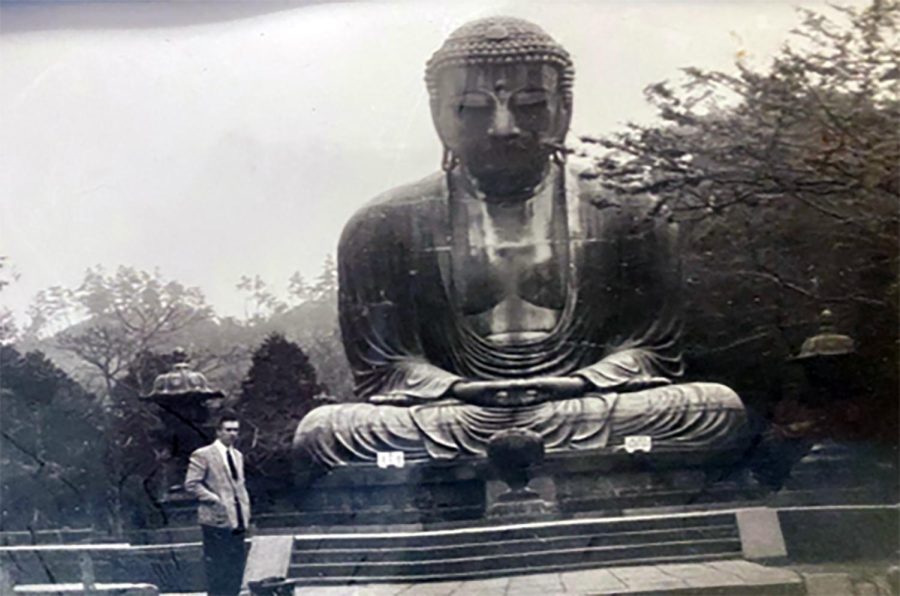Historically Speaking: Confessions of a writer
Tom Morrow, then a young writer from Iowa, at the world’s largest Buddha in Japan. (Tom Morrow photo)
April 16, 2023
Each of us has or will experience a good amount of history as life takes us from one day to the next. Do an assessment of your own life … you might be surprised.
For a kid born and raised in a southern Iowa farming community, I’ve seen a great deal of the world. I’ve interviewed more than my share of notables, history-making personalities, unforgettable characters and entertainers, as well as visited many historic sights.
The only thing I ever wanted out of Iowa was me. Often as the sun was setting, I would look west, picturing in my mind’s eye what might lie ahead. My philosophy of life was and still is: “dare to dream, dare to do” … and, boy, did I.
In high school, I learned a lot about history but struggled with anything involving numbers. I’m still waiting on a challenge involving “Algebra.” The most valuable thing I learned in 13 years of formal education was how to use a typewriter. It served me well in college, the military, and my profession. Mr. Gray, our commercial arts teacher, wouldn’t allow me and my two best friends to take more than one semester of typing. Said he, “Typing is a course for girls who will be seeking office jobs, not boys who’ll never have the need.” I don’t think he ever envisioned yours truly as a gatherer of historical “notes and quotes,” suitable for publication.
 Truth be told, I think old man Gray (he was way on the sunny side of 30) thought we were trying to skate through an easy course. He was partially right, but it proved to be one of the most valuable skills I ever learned. Being able to type got me the best details in the Navy. When it came to “volunteers,” if a “truck driver” was needed, you got to drive a mop. A request for a “typist” temporarily landed you in a nice comfortable office. In those days, only a small percentage of young sailors could type, but oh, could they swab a deck.
Truth be told, I think old man Gray (he was way on the sunny side of 30) thought we were trying to skate through an easy course. He was partially right, but it proved to be one of the most valuable skills I ever learned. Being able to type got me the best details in the Navy. When it came to “volunteers,” if a “truck driver” was needed, you got to drive a mop. A request for a “typist” temporarily landed you in a nice comfortable office. In those days, only a small percentage of young sailors could type, but oh, could they swab a deck.
I joined the Navy, presumably, to see the world, and I came very close to completing that task. Over the following six decades, I traversed this great country of ours coast-to-coast (several times), flew across the Pacific Ocean from San Francisco (Los Angeles and San Diego) to Hawaii, to Guam, the Philippines, Okinawa, Japan, the Aleutian islands Alaska, Midway, Iwo Jima, and the skinny coral reef of Kwajalein in the Marshall Islands. I cruised from Guam to San Francisco in an old World War II Liberty ship.
Later in civilian life as a travel writer, I flew and/or cruised thousands of miles around the Caribbean, across the Atlantic to the United Kingdom, rode the rails through Western Europe, went coast-to-coast in Australia. Caught a trout in New Zealand, visited four provinces of Canada, saw the volcanic nations of Iceland, Mexico, Costa Rica, Guatemala, El Salvador, Honduras as well as the Bahamas, Saudi Arabia, Aruba and the Virgin Islands. I’ve been in all U.S. states except two: North Dakota and Vermont.
I’m told I didn’t miss much in North Dakota. A close friend of mine, who is a native of that somewhat chilly territory, once told me the only thing stopping that cold Canadian winter wind blowing down from the north is a single barbed wire fence out at the edge of his hometown of Kensal.
But I digress.
The first historical event I vaguely remember was the World War II ending V-J parade on Aug. 15, 1945, along “O” street in downtown Lincoln, Nebraska. However, the event I distinctly remember was the June 25, 1950, invasion of South Korea by the communist North Koreans. That so-called “police action” sent a good many WWII veterans back into uniform during a prolonged bloody war costing more than 50,000 U.S. casualties.
As the decade of the ’50s traversed the calendar, there were other events such as the various school segregation battles and the Russians beating us into space with a 187-pound metal ball called Sputnik.
It wasn’t until Nov. 22, 1963, an historic event that, to this day, has affected American lives like no other: the assassination of President John F. Kennedy. Much like the bombing of Pearl Harbor, those who lived it remember exactly where we were when the announcement came across the airwaves. The likes of that historic event didn’t happen again until Sept. 11, 2001, with the attack on the World Trade Center in New York City.
We haven’t been the same nation since Kennedy’s death. It truly was the end of our “Camelot.” The idyllic days of the 1940s and ’50s were gone, never to return. It was a time only those of us who lived it can believe it ever happened.
At this point, you’re probably asking yourself, “What has any of this to do with history?” Most of these locations are central to World War II, all of history’s most important period, or you’ve heard stories from older family members who lived it. You’ll find most of these locations were where Americans fought and died in the name of freedom. Recorded history has never witnessed such events.
You might make an assessment of your own life’s experience … it may be something younger members of your family will find to be important in the historic scheme of things.
Tom Morrow is a longtime Oceanside-based journalist and author.
Columns represent the views of the individual writer and do not necessarily reflect those of the North Coast Current’s ownership or management.




